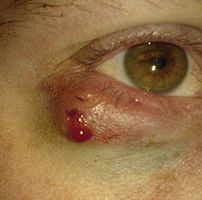Myopia (Short Sightedness):Myopia occurs when the eye is too long or when the cornea is too steep to focus the light precisely onto the retina. Instead, the light is focused on a point in front of the retina, resulting in poor distance vision. This is also known as short-sightedness or near-sightedness.
Myopia can be treated or correct with the aid of the following:
*Glasses/Spectacles
*LASIK (Laser in situ keratomileusis)
*PRK (Photo refractive keratectomy)
*IOL (Intra ocular contact lens implants)
*CLE (Clear lens extraction)
Hyperopia (Long Sightedness):
Hyperopia occurs when the eye is too short or the cornea too flat to focus the light precisely on the retina. Instead, the light is focused on a point behind the retina which results in poor near-vision eg. Poor reading. This is also known as long-sightedness or far-sightedness.
We can use various means to correct hyperopia:
*- LASIK (Laser in situ keratomileusis)
*- PRK (Photo refractive keratectomy)
*- IOL (Intra ocular contact lens implants)
*- CLE (Clear lens extraction)
.Astigmatism:-
…………….
Astigmatism is caused by either an irregularly shaped cornea or at times, by an irregularly shaped lens.
In a “normal eyeâ€, the cornea is shaped much like a round ball, and when light enters the eye, passes through the cornea and the lens, it is focused onto one precise spot on the retina.
In an astigmatic eye, the cornea is shaped more like a rugby ball. This shape causes the light to be focused on 2 or more spots on the retina instead of just the one, resulting in fuzzy vision.
Astigmatism can be corrected or treated with the aid of:
*Glasses/Spectacles
*Contact lenses
*LASIK (Laser in situ keratomileusis)
*PRK (Photo refractive keratectomy)
Presbyopia:-
The term presbyopia means that you are suffering from age-related stiffening of the lens. Most people who are over the age of 40 require glasses to read (even if they have never required seeing aids before). This is because the lens, which is the focusing element in the eye is less pliable and therefore less able to focus on close objects. This condition tends to worsen as time goes on, as further stiffening occurs in the lens.
Various means can be used to correct/treat presbyopia:
*Reading glasses/Spectacles
*Bifocal or varifocal glasses/spectacles
*Contact lenses (using a technique called
monovison.)
*LASIK (Laser in situ keratomileusis – using a
technique called monovison.)
*PRK (Photo refractive keratectomy)
Clear lens replacement (also known as Refractive lens Replacement or Intraocular Lens Replacement surgery IOL).
Monovision is a technique whereby one eye is adjusted for distance vision and the other for reading vision. This can be done with contact lenses or with surgery. Please see the MONOVISION subsection under “Refractive Lens Replacements†for further details.
Clear Lens Replacement surgery is increasingly becoming the preferred alternative for presbyopic patients who are finding it difficult to wear glasses or contact lenses.
.Strabismus (Squint):-
Strabismus (otherwise known as squint) occurs when the muscles which control the movement of the eyes do not function correctly. The eyes (or one eye) are often seen to be pointing in an unusual direction, prohibiting accurate focusing.
We can use various means to correct/treat Strabismus:
*Glasses/Spectacles
*Patches
*Botox injections administered to specific muscles of the eye.
*Strabismus sufferers are not prohibited from having other
*correctional treatments such as LASIK.
.Amblyopia (Lazy Eye):-
Many people make the mistake of thinking that amblyopia (or Lazy eye) is another name for strabismus (or squint). This is not true, however, strabismus may lead to amblyopia.
Squint is muscle-related condition, causing the eyes to point in different directions. You notice instantly when a person has a squint. Amblyopia is a condition which can not be seen. It is often very difficult to determine how a person became amblyopic.
In the case of amblyopia, we find that vision out of one eye is far better than that out of the other eye (for various reasons). Due to the comparative weakness in one eye, the brain will compensate by using the stronger eye most of the time in order to get a clearer image. This results in the weaker eye becoming “lazyâ€.
We test for amblyopia using eye charts and testing the visual acuity (clarity of vision) of patients.
Amblyopia can be treated or corrected by means of:
*Glasses/Spectacles
*PRK
*LASIK
Amblyopic patients are not prohibited from having other correctional treatments. In severe cases it may be recommended that certain treatments are not carried out.
Disclaimer: This information is not meant to be a substitute for professional medical advise or help. It is always best to consult with a Physician about serious health concerns. This information is in no way intended to diagnose or prescribe remedies.This is purely for educational purpose
Sources: http://www.eye-surgery-uk.com/eye_common.html

































